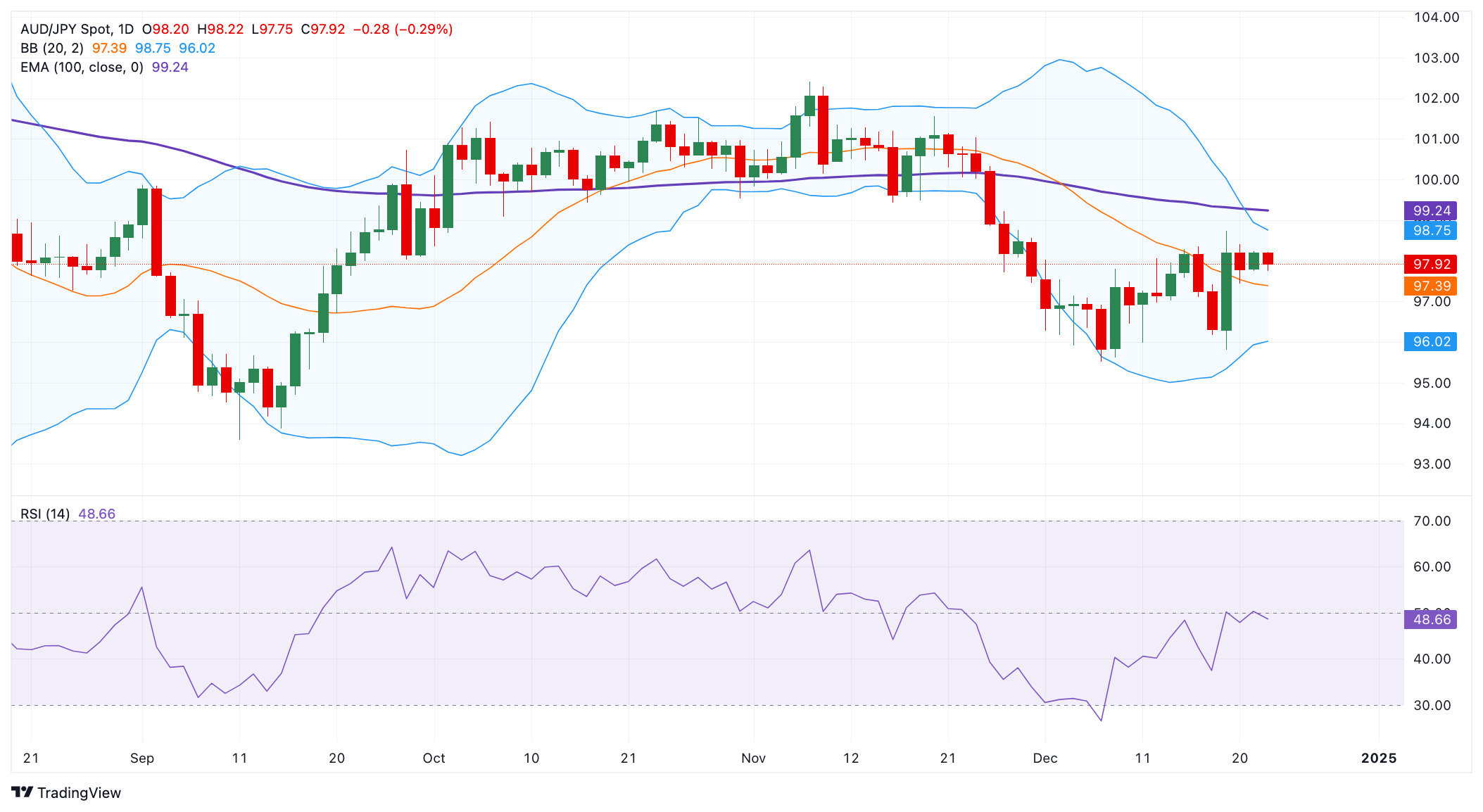AUD/JPY Price Forecast: Attracts some sellers below 98.00 amid intervention fears
- AUD/JPY tumbles to around 97.95 in Tuesday’s early European session, down 0.25% on the day.
- The cross keeps the negative view below the 100-day EMA with the bearish RSI indicator.
- The first downside target is seen at 96.00; the first upside barrier emerges at 98.74.
The AUD/JPY cross attracts some sellers to near 97.95 during the early European session on Tuesday. The Japanese Yen (JPY) edges higher after the verbal intervention from the Japanese authorities. Japan’s Finance Minister Katsunobu Kato said on Friday that they “will take appropriate action against excessive moves.”
According to the daily chart, AUD/JPY remains capped under the key 100-day Exponential Moving Averages (EMA), suggesting that the path of least resistance is to the downside. The downward momentum is reinforced by the Relative Strength Index (RSI), which stands below the midline near 48.00, supporting the sellers in the near term.
The lower limit of the Bollinger Band and round mark at 96.00 act as an initial support level for the cross. A breach of this level could see a drop to 94.78, the low of September 6. Further south, the next contention level to watch is 93.59, the low of September 11.
On the bright side, the first upside barrier emerges at 98.74, the high of December 19. The additional upside filter to watch is 99.25, the 100-day EMA. The 100.00 psychological level appears to be a tough nut to crack for bulls.
AUD/JPY daily chart
Australian Dollar FAQs
One of the most significant factors for the Australian Dollar (AUD) is the level of interest rates set by the Reserve Bank of Australia (RBA). Because Australia is a resource-rich country another key driver is the price of its biggest export, Iron Ore. The health of the Chinese economy, its largest trading partner, is a factor, as well as inflation in Australia, its growth rate and Trade Balance. Market sentiment – whether investors are taking on more risky assets (risk-on) or seeking safe-havens (risk-off) – is also a factor, with risk-on positive for AUD.
The Reserve Bank of Australia (RBA) influences the Australian Dollar (AUD) by setting the level of interest rates that Australian banks can lend to each other. This influences the level of interest rates in the economy as a whole. The main goal of the RBA is to maintain a stable inflation rate of 2-3% by adjusting interest rates up or down. Relatively high interest rates compared to other major central banks support the AUD, and the opposite for relatively low. The RBA can also use quantitative easing and tightening to influence credit conditions, with the former AUD-negative and the latter AUD-positive.
China is Australia’s largest trading partner so the health of the Chinese economy is a major influence on the value of the Australian Dollar (AUD). When the Chinese economy is doing well it purchases more raw materials, goods and services from Australia, lifting demand for the AUD, and pushing up its value. The opposite is the case when the Chinese economy is not growing as fast as expected. Positive or negative surprises in Chinese growth data, therefore, often have a direct impact on the Australian Dollar and its pairs.
Iron Ore is Australia’s largest export, accounting for $118 billion a year according to data from 2021, with China as its primary destination. The price of Iron Ore, therefore, can be a driver of the Australian Dollar. Generally, if the price of Iron Ore rises, AUD also goes up, as aggregate demand for the currency increases. The opposite is the case if the price of Iron Ore falls. Higher Iron Ore prices also tend to result in a greater likelihood of a positive Trade Balance for Australia, which is also positive of the AUD.
The Trade Balance, which is the difference between what a country earns from its exports versus what it pays for its imports, is another factor that can influence the value of the Australian Dollar. If Australia produces highly sought after exports, then its currency will gain in value purely from the surplus demand created from foreign buyers seeking to purchase its exports versus what it spends to purchase imports. Therefore, a positive net Trade Balance strengthens the AUD, with the opposite effect if the Trade Balance is negative.



